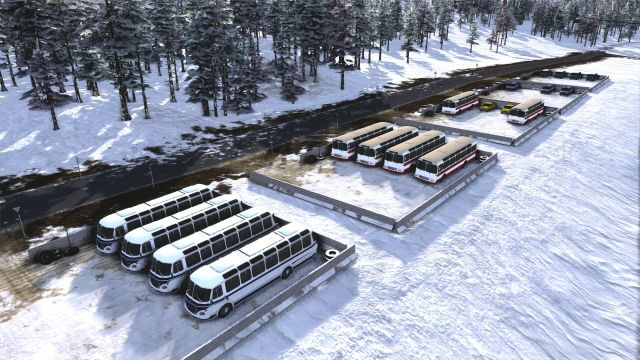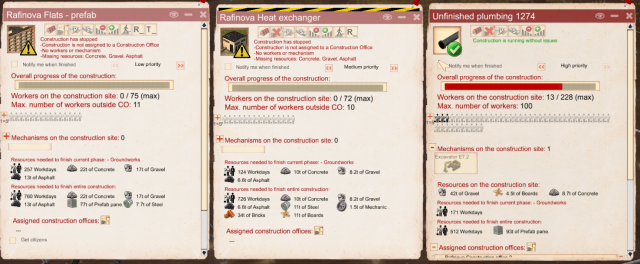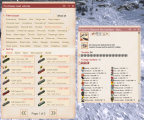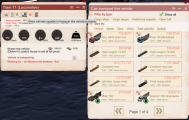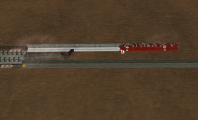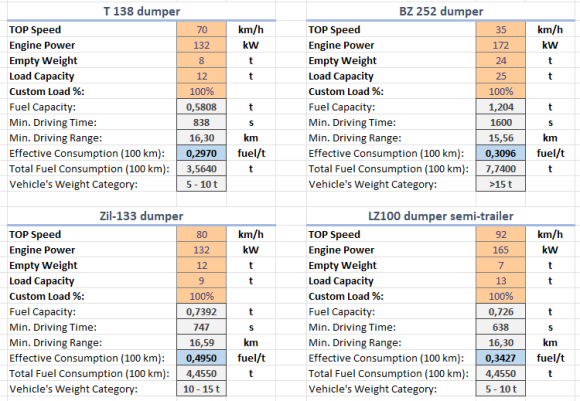Report for the community 58
Report for the community #58 is a report for the community released in september 4th, 2023.[1][2]
Content
The report informs about the development of the game. Detailed information about the fuel consumption change.
Transcript
But let us focus on what is new in the game now. First, we want to mention that we added priorities for construction sites. What does that mean? Before all construction sites had the same priority and the construction offices were dealing with them in FIFO (first in first out) order, which meant the first placed building was prioritized and often you encountered problems because you needed to construct something else first, but Construction Offices insisted on Constructing something else if you did not pause those constructions. Now with update every construction site will have option in its window for 3 levels of priority (low, medium, high). Every construction will start with low priority as default, and you will be able to raise priority of any construction site according to your needs. This will be useful especially in massive construction projects with multiple construction sites for those who use Auto search in Construction Offices. You need a certain road first? Or a medium voltage wire with the substation? Just raise their priority and Construction Offices will go for those first.
From other changes that are interesting we want to mention that you will be able to transport some single car trams by trucks if you want to use them, but you do not have a rail connection from the tram depo to the border or to the Railway Production Line. Then you will be able to access remote (aerial/ship) customs from your screen because there will be shortcuts on your screen above the minimap, and it will also be possible to purchase trains at remote (aerial/ship) customs and bring them in by a ship, but you will need a harbour for containers to unload them. Besided that, there will be an info about which ship, or helicopter can load the vehicle. You will also be able to purchase tram trainsets in tram depo now. From other things, we made it possible to adjust tunnels during planning by small pieces without the need of deleting the whole segment and updated the pedestrian underground entrances to fit in between metro tunnels near metro stations.
And now some additional information about the fuel consumption change. Initially we mentioned that fuel consumption will include some air-drag factor to give faster driving vehicles higher consumption, but it was implemented differently because of potential performance issues.. Before the update, vehicles driving slower had higher fuel consumption than vehicles driving faster because it was consumption per second, and it did not count for the actual speed of the vehicle. Now after the change the vehicle’s consumption is dependent on its speed and the consumption over distance should be the same at all speeds. There are quite a few vehicle types in the game and there are several weight categories and conditions for their consumption so it is not possible to show you the calculation formula for all, but we can share at least the calculation formulas for road vehicles and aerial vehicles as these are the simplest. Here you can see the weight factors for all vehicle types.
The vehicle’s fuel capacity depends on its empty weight and engine power. Heavier vehicles have more fuel capacity than small vehicles and more engine power means more fuel capacity too. There are 5 categories of vehicles: personal cars and small vans (0-2 t); small buses and trucks (2-5 t); normal buses and trucks (5-10 t), large buses and trucks (10-15 t); and largest trucks (>15 t). There are few weight categories other vehicle types too, but they are less diverse than road vehicles and most of fuel consumption for your Republics comes from road vehicles and they are most important for the early game overall fuel consumption too. Later you may not care about the consumption that much as you may have your own fuel. Also, this is not important for those who play without fuel consumption in their Republics. They do not need to care about these parameters. Here is the formula for fuel capacity. It applies to all ground and water vehicles, but you need the proper weight factor to get the exact number.
[Fuel Capacity] = ([Engine Power] / 500) * [Max Fuel Weight Factor]
Aerial vehicles have a different formula.
[Fuel Capacity] = (sqrt[Engine Power] / 10) * [Max Fuel Weight Factor]
Then the vehicle’s consumption per second now depends on its engine power, TOP speed, weight category and actual load. Vehicles with higher engine power have higher consumption. Vehicles with same engine power but higher TOP speed have higher consumption and heavier vehicles have higher consumption even if they may have other parameters the same. Then there is the load factor for vehicles which affects their actual consumption. Road and aerial vehicles consume 25% more fuel when fully loaded, ships consume 50% more fuel when fully loaded, and it is a bit more complicated with trains. Each empty wagon adds 2,5% to consumption of the locomotive and if it is fully loaded it adds another 5%. So, if you have a locomotive towing 12 empty wagons it will have 30% extra fuel consumption. If the wagons would be fully loaded the consumption would be 90% higher than locomotive driving without wagons. There is also an acceleration factor for vehicles consumption, but it does not have a massive impact on overall fuel consumption. So here is the formula for fuel consumption calculation which applies for road vehicles. Aerial vehicles use different formula and railway vehicles have some other hidden calculations which cannot be easily included in this. You can ignore the Speed Factor because its function is just to make the consumption over distance the same for all speeds of the vehicle.
[Consumption per second] = 0,1 * [Engine Power] * 0,01 * [TOP Speed] * [Consumption Weight Factor] * 0,01 * [Speed Factor] * (1 + ([Load %] * 0,25))
Aerial vehicles use this formula.
[Consumption per second] = 0,1 * sqrt[Engine Power] * 0,01 * [TOP Speed] * 0,01 * [Consumption Weight Factor] * 0,1 * [Speed Factor] * (1 + ([Load %] * 0,25))
We know this is quite a lot of information and we cannot share all the details. Most valuable information for you is that vehicles should have similar fuel consumption like they had before, but they will not consume more when they are forced to drive slower than they can. Other important thing are the driving ranges and those should still stay above 15 km on one tank for smaller trucks and well exceeding 20 km for locomotives. We also prepared a fuel consumption calculator which will allow you compare different road vehicles to decide what is more economical for your transportation needs. Not always bigger is the better because you need to consider how much vehicle consumes for its load transported over certain distance, so in the spreadsheet you can use the “Effective Consumption (100 km)” as a gauge to compare different vehicles. This way you now how much fuel vehicle consumes for each transported ton. Then you have the “Total Fuel Consumption (100 km)” which is the amount of fuel the vehicle uses to move 100 km depending on its load. You can easily recalculate these numbers to different amounts of distances if you want. The basic rule is lower is better. Here is the link to the calculator. https://1drv.ms/x/s!AupeI3t5EG4Egottag6jMPB-BokIhw?e=1oqQT2
Because of complications we cannot make a calculator for trains now and planes and ships may be added later.. But there is not that much to compare as there is for road vehicles. Trains are much more economical than road vehicles are, and then aerial vehicles are more expensive to use. Just for comparison, the fuel cost for passenger transportation using a helicopter may be 10x higher per passenger than when you would use a bus, but you can move passengers faster and over longer distances. Also, some normal weight category trucks may have the same “Effective fuel consumption (100 km)” as larger trucks have. As example we can use a vehicle with 150 kW engine and 100 km/h TOP Speed. Normal truck with 12 tons load capacity has the same “Effective fuel consumption (100 km)” as larger truck with 15 tons load capacity and largest truck with 20 tons load capacity if all of them have the same engine power and TOP speed. Based on that it may make sense to use smaller trucks with lower TOP speed in certain situations or larger trucks in another situation. Here you can see a comparison of several dumpers as example.
We hope this information helps you to better understand how the game works and make better planning decisions. We cannot give you everything because it is quite complicated but at least we want to share the less complicated stuff and you can see there is always a lot of room for something going wrong, as you cannot see in these formulas what would make the bus fuel consumption break specifically for buses working on lines. There are hidden calculation which have affect but you can make comparison of how effectively vehicles use fuel with these formulas.
We will continue to deliver fresh updates from the development process and if we find a way also some useful information from under the hood. We may also consider making some changes for our official communication to be able to make extra announcements using our Discord or Facebook. For now, we continue to work on fixing the bugs which prevent us from releasing the current update for public testing. So please stay patient, do not forget there is a life to live and enjoy outside the game, stay safe and tuned for the next report.
Thank You for Your Support
3Divison Team</poem>References
| Workers & Resources: Soviet Republic | |||||||||||||||
|---|---|---|---|---|---|---|---|---|---|---|---|---|---|---|---|
| DLCs | |||||||||||||||
| Content packs | |||||||||||||||
| |||||||||||||||
| |||||||||||||||
| |||||||||||||||
 Hooded Horse Wikis
Hooded Horse Wikis